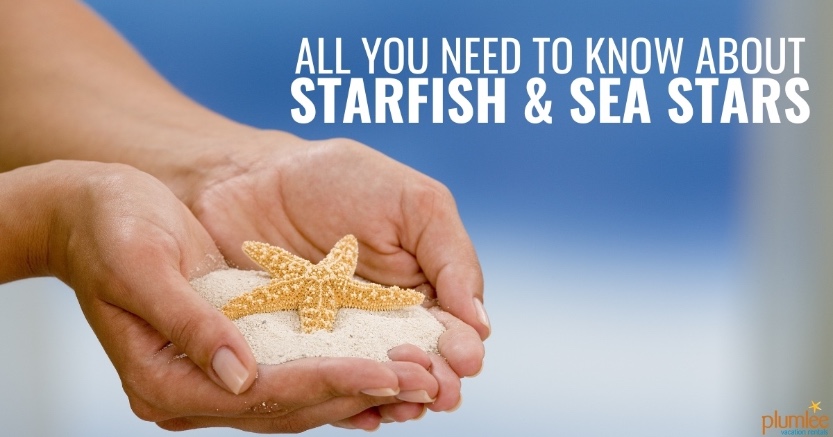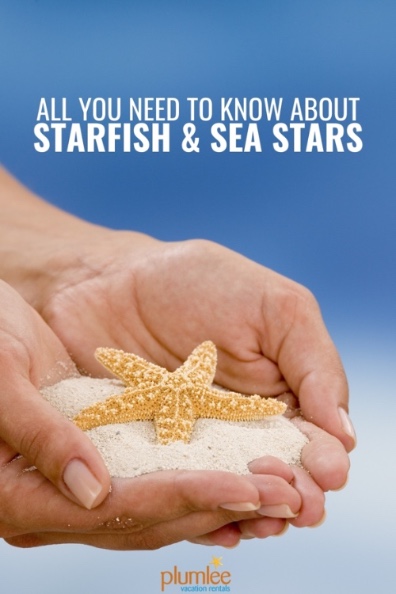
So how much do you REALLY know about starfish and sea stars? Well you’re about to find out! We’ve rounded up the most fascinating fun facts about these amazing creatures that can be found all along the Florida Gulf Coast. You may even stumble upon one as you stroll the beach outside your Indian Rocks Beach vacation rental. These incredible echinoderms are worth getting to know more about, so here you go.
⭐️ FUN AND FASCINATING FACTS ABOUT STARFISH & SEA STARS ⭐️
We have two awesome starfish videos for you to watch, but first start off by reading these fast fun facts. How many do you already know? Let’s find out!
- Starfish should really be called sea stars. They’re actually related to sand dollars and sea urchins. They do not have gills, scales, or fins like fish do. So because they are not classified as fish, scientists prefer to call starfish “sea stars.” The taxonomy of sea stars is: Classification: Invertebrate; Phylum: Echinodermata; Family Asteriidae .
- There are around 2,000 species of sea stars. Some live in the intertidal zone, while others live in the deep water of the ocean. While many species live in tropical areas, sea stars can also be found in cold areas—even the polar regions. However, they cannot survive in fresh water. Nope!
- Sea stars don’t have a brain or blood. Sea stars have a circulatory system made up primarily of seawater. Seawater is pumped into the animal’s water vascular system through its sieve plate.
- Sea stars move using hundreds of tube feet located on their underside. The tube feet are filled with seawater, which the sea star brings in through the madreporite on its top side.
- They can have up to 40 arms. While you might be most familiar with the five-armed species of sea stars, not all of them have just five arms. Some species have many more arms—like the sun star, which can have up to 40 arms.
- Sea stars have eyes on the tips of their arms. This allows them to sense light and dark—and to find food.
- They eat inside out. When they capture prey, they have tiny suction cups to grab ahold of their food. Then their stomach exits their mouth to digest the food, and reenters the body when they’re done eating. Crazy, right?
- Sea stars prey on bivalves and mollusks. This includes clams, oysters and mollusks. They also enjoy eating small fish, snails, and barnacles.
- Sea star predators include certain fish species, sharks, manta rays and even other starfish. A sea star’s spines are used as protection from birds, fish, and sea otters.
- Sea stars have several effective defense mechanisms. As well as their tough, prickly, armor-like skin, some have striking colors that camouflage them among the plants and coral. Starfish and sea stars are also able to regrow lost or damaged limbs. When under attack, some starfish will even shed an arm to escape the predator.
- Sea stars aren’t social creatures but are solitary and spend most of their life alone. They will sometimes congregate in large groups during certain times of the year to feed.
Sources:
WATCH THIS UP-CLOSE VIDEO OF A SEA STAR WALKING ON THE BEACH
Sea stars are beautiful creatures to observe and incredibly fascinating to watch as they move through the water and along the sand.
If you’ve never seen a starfish up-close, then you must watch this video. It captures the amazing footwork, or more appropriately arm-work, of this graceful creature.
Just remember that Florida law does not permit the taking of any live organisms (that include shells that still contain something living), so just observe if you happen to stumble upon a live one on Indian Rocks Beach or Indian Shores beach. If you think the sea star is stranded or struggling, then carefully move it to the water’s edge.
WATCH THIS VIDEO ALL ABOUT HOW AMAZING SEA STARS ARE AND HOW THEY MOVE
This video captures the wonderful qualities that make sea star and sea stars unique and oh so intriguing. The footage in this video is captivating as you get a glimpse into the underwater life of these solitary sea creatures.
Did you even know that a sea star can gallop? It’s so cute! Watch how and why it moves this way.
Before you start the video, gather your kids around so they can enjoy this quick and educational science lesson before, during, or after your Florida Gulf beach vacation.
You never know when you’ll see one, so be prepared and get to know them better right here, right now.
WHAT IS ONE SEA STAR FACT THAT YOU LEARNED from reading this?
Let us know in the comments below!





